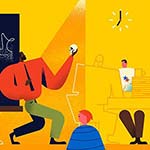

Learn: Transforming the learning experience, through technology
When School Becomes a Game
How can educators get students to be more engaged? Some experts say it's a matter of gamifying the learning experience.
Every year, the American Psychological Society talks to Americans about their mental state. In 2013, the topic was stress—and the group found that, of the teenagers who responded to the survey, more than 80 percent said that school is either a somewhat or significant source of stress in their lives. Ten percent reported that their grades suffered due to stress.
In an effort to reduce school-related stress, teachers at all levels, from preschool through adult coursework, are bringing the elements of gaming into their classrooms and assignments. In other words, they’re gamifying education.
Psychologists say this works because games motivate people to satisfy their psychological needs. In games, players experiment until they find an approach that gets them to the next level, score a goal, or accomplish something. In school, students start with a perfect score and lose points as they go on. It’s a lot more fun—and a lot less stressful—to achieve something than to constantly risk losing points. Through recent advances in technology, professors and administrators have begun to incorporate these rudimentary tenets of gaming into their lesson plans.


Exploring what happens when possibility becomes reality.
Professor Lee Sheldon was one of the early pioneers in the field. It’s hardly surprising, given his job title: Sheldon teaches interactive media and game development at Worcester Polytechnic Institute in Massachusetts.
“When I first started [teaching], I didn’t really know what I was doing, and I was lecturing, and it was boring. If it was boring for me, I knew it was boring for the students,” he recalls. He debated how to make his classes more interesting and landed on a question: “I said, ‘Well, you design games, so why not turn the entire class into a game?’”
Sheldon divided his students into teams, called guilds, based on each student’s interests and skills. He then created a narrative through which the students would navigate throughout the course. This narrative would teach them the subject and keep them committed to the course. It functions much like a video game, in which players work their way through a landscape or a story. As they complete a stage or a task, they advance to the next challenge. Setbacks mean they circle back and try another approach; they have room to experiment without feeling as if they’ve failed. And rather than grading students with standard letter grades, in which points are deducted from a total score based on incorrect answers, Sheldon used a system from the gaming world: experience points, or XP. Students accumulate XP by answering questions correctly and attending class.
“It seemed more reasonable to reward them, because that’s what you do in games. You try not to punish people,” Sheldon said. His strategy comes directly from psychological principles known as intrinsic and extrinsic rewards. Extrinsic rewards are those that come from something beyond the person, such as grades or trophies. Intrinsic rewards come from within the person, like a sense of achievement.
“Because they had peer congratulations, that intrinsic reward is so much stronger than just a grade,” Sheldon said. “They get hugs, they get high fives, fist bumps, whatever it is that is enough for them to try and study for the exam.” They become more invested in their academic achievement.
Sheldon is onto something. According to Futurism.com, a website that regularly covers the work of futurists, “Gaming outperforms textbooks in every area. Pilots and surgeons trained on video games and simulations outperform those who are not. Customized gaming teaches creativity and innovation. Hours spent playing video games are associated with increased executive function in children. And so on.” Futurists say this sort of shift could begin to reduce the number of high school dropouts across the U.S.—currently about 1.2 million per year—if implemented properly.
The trend is already picking up around the world. Whether helping educators shift grading systems or take smaller steps, such as gamifying individual lesson plans, multiple resources exist to show teachers the way. One of those is The Multiplayer Classroom, a 1,500-member Facebook group that teaches game design techniques. Tech start-ups and apps are also following the gamification trend. FoldIt, for example, asks science students to play games that actually help solve scientific questions, such as how proteins fold in certain diseases. It’s crowdsourcing scientific research in a way that keeps students engaged.
According to Sheldon, teachers of any course or subject matter can use these techniques to better motivate their students. “I have not yet found a subject that cannot be taught with a game,” he said. And that could help students level up in their education, with less stress.

The Possibility Report is an ongoing series about how technology is changing our understanding of the world around us. This article is part of LEARN, our discussion on how emerging technologies promise to change the educational experience as we know it, from elementary schools to prisons and everywhere between.










